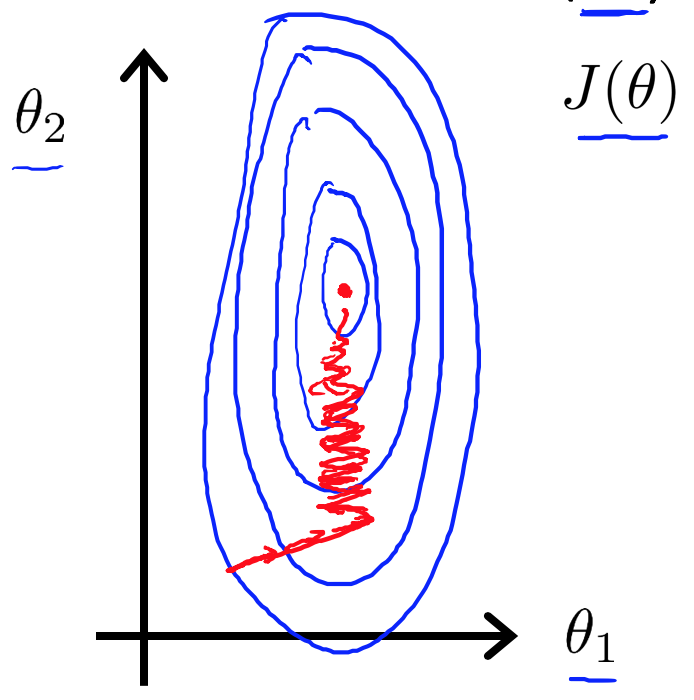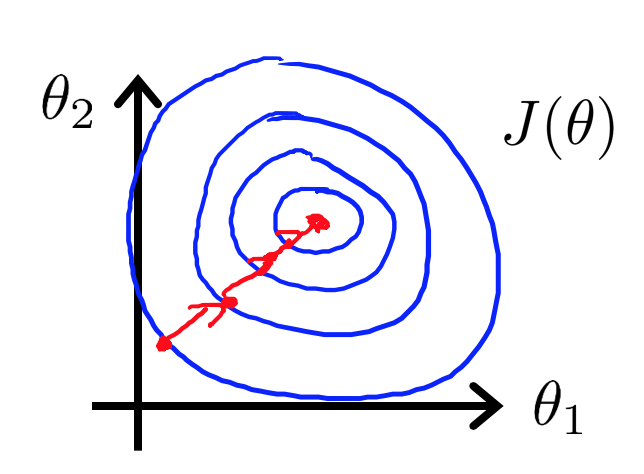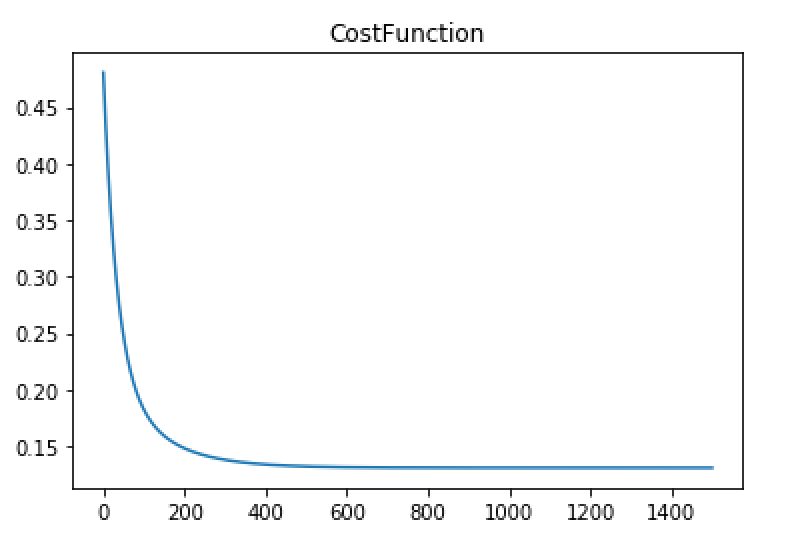【向量化】
单一变量的线性回归函数,我们将其假设为:但是如果我们的变量个数不止一个的话,那么我们的假设函数就应该是如下的形式:其中n-1为数据集中特征属性的个数
为了结构的统一,我们引入,则上式转化为如下的形式:
进而对其进行向量化,上式可以转换为:
其中的列向量,,再次强调中的是一个始终为1的属性。
对于正则化的梯度下降公式的推导如下:
对进行求偏导:
其中对于矩阵求导,请自行查阅矩阵求导变换公式
进一步,那么梯度下降迭代公式如下所示:
【向量化的优点】
向量化相对于for循环而言,能一次性计算整个数据集,效率有明显的提升,并且Python内部对矩阵运算也进行了优化,能够充分利用计算机并行运算的能力。当然同时也有缺点,就是相对于for循环而言,理解起来更复杂。
【相关知识点——特征缩放】
特征缩放,能够有效的提高梯度下降的速率,减少迭代次数,使梯度下降算法更快的收敛。如果一些特征的取值范围较大,另外一些特征取值相对较小,那么绘制出的等高线图,便会便显出长扁的外形特征,如下图(来源吴恩达讲义):
那么梯度下降迭代就会表现出弯弯曲曲迭代的特性(图中红色轨迹),而对于特征范围接近的数据集,其等高线图如下所示:(来源吴恩达讲义)
很明显等高线越圆,迭代速度越快。
通常对于特征范围较大的变量,我们的解决办法是:尝试将所有特征的尺度都尽量缩放到-1 到 1 之间,通常我们采用以下方法对特征进行缩放:
其中是平均值,是标准差。
具体代码实现如下:
#多变量梯度下降算法的实现,数据集采用吴恩达机器学习教程“ex1data2.txt”
#对于多变量线性回归梯度下降算法的实现,这里采用向量化的方式去进行
import numpy as np
import matplotlib.pyplot as plt
import pandas as pd
def readData(path,name=[]):
data = pd.read_csv(path,names=name)
data = (data - data.mean()) / data.std()
data.insert(0,'First',1)
return data
def costFunction(X,Y,theta):
inner = np.power(((X * theta.T) - Y.T), 2)
return np.sum(inner) / (2 * len(X))
def gradientDescent(data,theta,alpha,iterations):
eachIterationValue = np.zeros((iterations,1))
temp =np.matrix(np.zeros(theta.shape))
X = np.matrix(data.iloc[:,0:-1].values)
print(X)
Y =np.matrix(data.iloc[:,-1].values)
m = X.shape[0]
colNum=X.shape[1]
for i in range(iterations):
error = (X * theta.T)-Y.T
for j in range(colNum):
term =np.multiply(error,X[:,j])
temp[0,j] =theta[0,j]-((alpha/m) * np.sum(term))
theta =temp
eachIterationValue[i,0]=costFunction(X,Y,theta)
return theta,eachIterationValue
if __name__ == "__main__":
data = readData('ex1data2.txt',['Size', 'Bedrooms', 'Price'])
#data = (data - data.mean()) / data.std()
theta =np.matrix(np.array([0,0,0]))
iterations=1500
alpha =0.01
theta,eachIterationValue=gradientDescent(data,theta,alpha,iterations)
print(theta)
plt.plot(np.arange(iterations),eachIterationValue)
plt.title('CostFunction')
plt.show()
运行结果如下图:
点击查看更多内容
5人点赞
评论
共同学习,写下你的评论
评论加载中...
作者其他优质文章
正在加载中
感谢您的支持,我会继续努力的~
扫码打赏,你说多少就多少
赞赏金额会直接到老师账户
支付方式
打开微信扫一扫,即可进行扫码打赏哦








